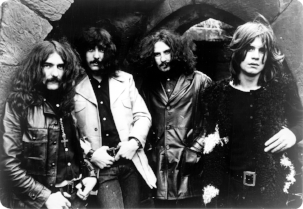The godfathers of metal began their career with a musical interval that was strictly forbidden by the church for centuries.

Witchcraft & Satan are not subjects often broached in classrooms, unless you are teaching The Crucible in a 10th grade English classroom. However, this song, about pagan rituals, can also be a useful tool in the music classroom. There is a definite connection between rock'n'roll & the occult that should be discussed before any in depth study of the genre. That and you're likely to find at least one kid in any class who knows something about Black Sabbath -- it's an excellent hook as you're studying intervals.
This song can also be used as an accompaniment example when teaching species counterpoint or music history, demonstrating how the concept of the devil is represented in music. It's also great to talk to students about the tritone as a representation of the devil in music and then play the example of a tritone that students are likely most familiar with: the opening theme to The Simpsons.
“Black Sabbath” - Black Sabbath
Intro: Considered one of the pioneering heavy metal bands, Black Sabbath formed initially as a blues band in Birmingham, England. Before they began their recording career, they embraced themes of the occult in their lyrics and alternate guitar tunings, creating their signature sound. The song “Black Sabbath” appears on the 1969 album of the same name. The band continues to tour today, including three out of four of their original members. Black Sabbath has sold 70 million records, won two Grammys and been inducted into both the UK Music Hall of Fame and the Rock and Roll Hall of Fame.
Analysis: The primary riff used in “Black Sabbath” is based on (and begins with) the tritone interval, which is significant for several reasons. First of all, Black Sabbath guitarist Tommy Iommi here uses the tritone interval, which occurs in the blues scale, showing Iommi’s connections in playing blues music. Additionally, the tritone has been historically known as a musical representation of the devil, also known as Diabolus in Musica, which matches the lyrical content of the song. This interval occurs throughout the song.
Considerations for Teaching: Particularly in this first single from the band, themes of the occult and imagery of Satan are prevalent. Although connection to objectionable material has been a hallmark of rock’n’roll since its inception and the historical use of the tritone as the diabolus in musica is a valid music history concept, teachers should be aware of this particular lyrical content. Teachers should be sympathetic to the religious beliefs of students, which may preclude them from listening to this song.

